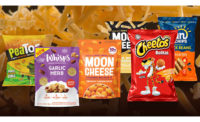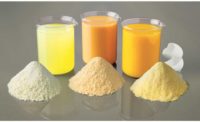Cheese strives for more transparency, clean label ingredients



courtesy of Land O’ Lakes Ingredients



I have a former boss who used to say that whatever food a consumer liked, chances are they would like it even more if it were topped with cheese. Considering all of its dairy splendor, it’s no wonder that cheese is big business. In its “What’s in Store 2017” report, International Dairy-Deli-Bakery Association (IDDBA) notes retail cheese sales in the U.S. reached over $23 billion in 2015. This reflects an astounding 24 percent growth over a five-year period. If cheese continues its upward trend, the report notes category sales would reach almost $28 billion by 2020. Per capita cheese consumption in the U.S. for 2014 was a whopping 34 pounds per year. The top cheese varieties, based on volume sales, are Cheddar, American, cream cheese, mozzarella and Colby/Jack blends. Of these top 5 varieties, the biggest increase in volume is in mozzarella, showing a 7.7 percent growth in the first six months of 2016.
What are some of the purchase drivers for cheese? In the age of increased protein, the high protein content of cheese makes it a go-to food for many consumers. The IDDBA report indicates consumers have positive attitudes toward dairy fat. Other reasons consumers cite for buying cheese are high quality ingredients, affordability, increase calcium intake and variety of formats. And Rachel Kerr, public relations manager, Wisconsin Milk Marketing Board, Madison, notes that the increase in snacking behavior, in general, also contributes to the popularity of cheese. “Sales of cheese snacks like string cheese, cheese sticks and cracker cuts continue to grow in part due to consumers looking for high-protein, healthy and convenient snacks, like cheese, that fit a busy lifestyle,” she says.
Cheese is a great fit for use in snacks and baked goods. Melissa Muldowney, strategic marketing director, dairy, Kerry, Beloit, WI, says that for salty snacks, cheese is a major flavor segment and remains on a growth trend. “Cheese is the No. 1 selling flavor in the puffed salty snacks category and continues to grow year after year,” she says. “In 2016, cheese as a flavor in puffed snacks reached $470 million, and that was a 6.8 percent increase over the prior year.”
A cleaner cheese
Cheese can easily fit into a desire for more natural ingredients and clean labels. Muldowney says that although dairy provides a natural, familiar taste that consumers like, consumers prefer to see a simplified ingredient statement and more transparency. For snack manufacturers looking to achieve “great taste and nutrition with clean-label dairy, Kerry provides natural flavors and taste systems, including project-verified non-GMO cheese options,” she says.
Some consumer groups are also moving away from artificial colors. John McDonald, R&D fellow and technical director of custom solutions, Land O’ Lakes Ingredients, Arden Hills, MN observes that using FD&C artificial colors in snack foods was the norm until a few years ago. Now manufacturers are searching for more natural color solutions. Ingredient suppliers have met the color challenge by developing cheese powders using vegetable extracts. “We’ve introduced a line of cheese powders with no FD&C colors or artificial flavors, called CheddarChroma,” he says. “We can deliver a bright-orange color with a Cheddar and blue cheese flavor profile that provides an economical sharp Cheddar cheese flavor for snack applications and seasoning blends.”
Flavor trends
Anne Druschitz, corporate research chef, Edlong Dairy Technologies, Elk Grove Village, IL sees two dairy trends in snack and baked goods categories: bold and authentic. “Cheese and herb potato chips just don’t cut it these days,” comments Druschitz. “Current chips on the market are seasoned with combinations like feta, rosemary and lemon or smoked Gouda and chive. Authentic tastes can conjure up a sense of place and can help tell the story of your product.” As examples, she gives Edam cheese and the Netherlands, Gruyère cheese and Switzerland and Taleggio and Italy.
“With the amount of information readily available through websites, consumer groups and social media, discovering brand stories and product backgrounds have never been easier,” says Carrie Schroeder, business development manager, Kerry. “Making product information like ingredient origin and manufacturing processes accessible to the consumer will help build loyalty and trust.”
Even pizza, a tried and true favorite food, is undergoing some transformations in the crust, the cheese and the toppings. “Consumers are moving away from indulgent, thick-crust, creamy-sauced pizzas to flatbread pizzas with fresh, locally sourced ingredients,” says Kerr. “But this doesn’t mean less flavor. Spicy cheeses infused with jalapeño, pepper, garlic and herbs, and sweet pizza sauces like Buffalo and barbecue, continue to be on the rise.”
Butter is also a great flavor-builder. Whether you are making pizza or cookies, getting the right dairy flavor profile at the right cost and with good runnability can be challenging. “Making your cookies taste more buttery by adding more butter to your formula can cause production issues and isn’t cost-effective,” says Druschitz. “When the prices of dairy commodities fluctuate, profitability is affected. Concentrated dairy flavors can provide consistent, economical solutions to these challenges.
“Another challenge is sourcing, especially when it comes to specialty cheeses that are extremely perishable or may only be produced in certain parts of the world or at certain times of the year,” continues Druschitz. “Using more readily available dairy ingredients to provide your base notes and adding signature top notes with flavors is just one way to give the consumers the authentic taste they are looking for.”
What’s next
Looking for the next flavor trend in cheese and dairy is an ongoing process, and most cheese and dairy suppliers utilize multiple approaches. “We utilize a comprehensive approach to discovering new flavor trends, including identification of macro-level consumer behavior drivers, technological advances and market place dynamics,” says David Banks, market research and consumer insights director, Kerry. “We also partner with multiple secondary research companies to quantify customer, brand product and flavor performance.” Kerry also uses social media monitoring, sensory analysis and culinary immersions. “We are constantly looking for new trends in the marketplace,” he says.
Cassandra Edwards, marketing communications manager, snacks, Kerry, sums up the cheese flavor space: “The most-exciting snacks are those that deliver a delicious taste while having a recognizable, approachable label. Manufacturers are getting close to cracking the clean-label challenge but there is room to improve, especially in the realm of cheese flavor and powders. Opportunities to offer ingredients that add the cheese flavor without stripping away the nutritional qualities will thrive. Look for this breakthrough to come soon.”
Looking for a reprint of this article?
From high-res PDFs to custom plaques, order your copy today!








